Catocala briseis
Catocala briseis
kah-TOCK-uh-lahmbrih-SAY-ihs
W.H. Edwards, 1864
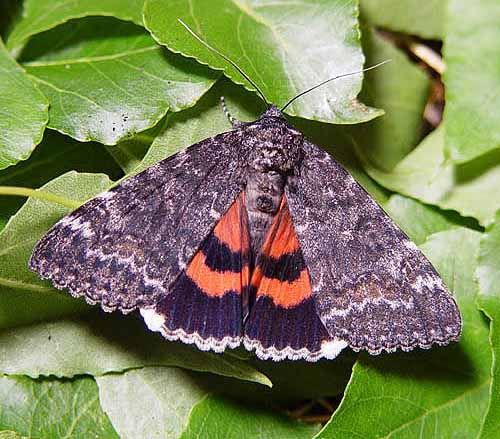
Catocala briseis
courtesy of Martin Jagelka.
This site has been created by
Bill Oehlke.
Comments, suggestions and/or additional information are welcomed by Bill.
| TAXONOMY:
Superfamily: Noctuoidea
Family: Erebidae, Leach, [1815]
Subfamily: Erebinae, Leach, [1815]
Tribe: Catocalini, Boisduval, [1828]
Genus: Catocala, Schrank, 1802
|
DISTRIBUTION:
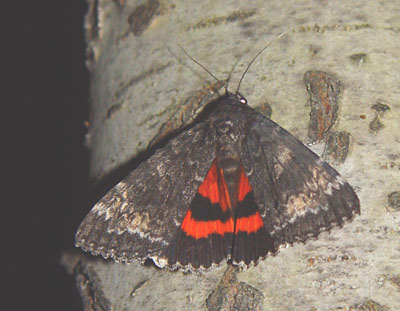 |
Scott Shaw reports briseis is common
"on Pole Mountain, in the Medicine
Bow Forest, Wyoming, about 10 miles east of Laramie near I-80 in
the mountain willow bogs."
Image to left, courtesy of Tim Dyson copyright,
Peterborough, Ontario, August 16, 2004. |
It has also been reported in
Delaware,
Idaho,
Illinois,
Maine,
Massachusetts,
Michigan,
Minnesota,
Montana,
Nebraska,
New Hampshire,
New York,
North Dakota,
Ohio,
Oregon,
Rhode Island,
South Dakota,
Utah,
Vermont and
Wisconsin.
Moths previously designated as Catocala minerva are now recognized as being synonymous with
Catocala briseis.
Tom Middagh confirms them in Minnesota.
Visit Catocala briseis recto and verso, 67mm, Regina, Saskatchewan, August 3, 2008, courtesy of Tim Taylor.
Visit Catocala briseis recto and verso, 64mm, RCanyon Creek, Ravalli County, Montana, August 17, 2009, courtesy of Travis Koch.
The forewings are predominantly a mottled dark-grey-brown
with some lighter areas 1) between the postmedial and subterminal lines,
2) at the very base of the antemedial and postmedial lines along the
inner margin, and 3)over the subreniform spot running diagonally
toward the costa. The postmedial lines do not have greatly elongated
and sharly pointed "teeth" near the apex. The hindwing fringe is white
and unbroken and the inner black band (fairly even) reaches the inner margin.
| 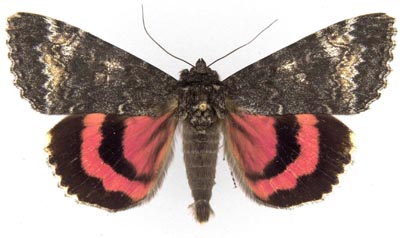
Catocala briseis, Manitoba |
Form "albida" has forewings that are light grey.
Other forms include "briseana" Strand, 1914, and "clarissima"
Beutenmüller, 1918. Cassino described the subspecies minerva
in 1917, now (2010) recognized as synonymous with Catocala briseis.
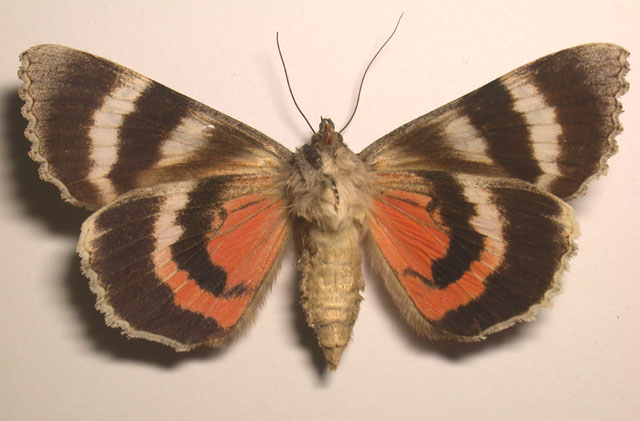
Catocala briseis female, Longueuil, Quebec,
taken at bait, August 2000, courtesy of Pierre Legault.
Like Catocala parta, Catocala briseis has a well formed
discal lunule in the cell on the ventral surface of the hindwing. In
C. briseis the basal area and the cell are almost completely
filled with red.
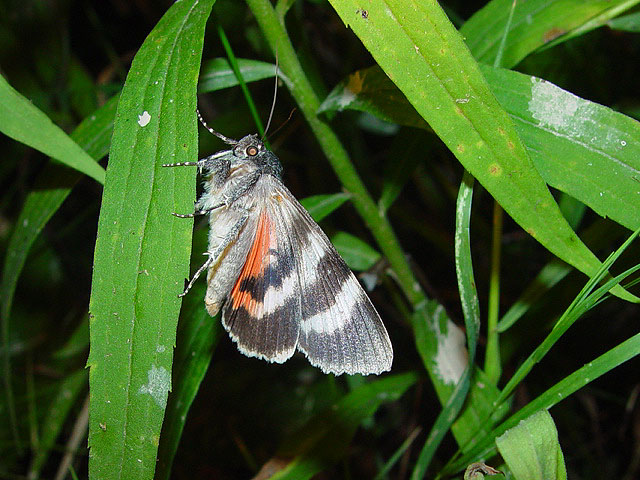
Catocala briseis, Peterborough, Ontario, July 22, 2005, courtesy of Tim Dyson.

Catocala briseis, Peterborough, Ontario, July 22, 2005, courtesy of Tim Dyson.
Groteiana is similar but has an inner black band that
terminates well before the inner margin. Unijuga and meskei
are similar to specimens of briseis that lack the lighter area
between the postmedial and subterminal lines, but both those species have
much more irregular hindwing bands. Parta has lighter coloured
"orange" bands on the hindwings as well as fringe that is checked.
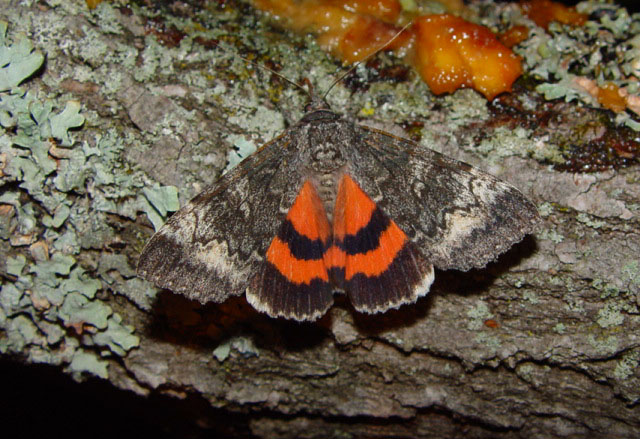
Catocala briseis, courtesy of Tim Dyson, copyright
Peterborough,
Ontario, August 16, 2004.
FLIGHT TIMES AND PREFERRED FOOD PLANTS:
Catocala briseis are usually on the wing from July to September
in Quebec, where it is common, with
specimens being taken as late as early November.
Tim Dyson took this image of a fresh one (unnamed dark form) in
Peterborough, Ontario, July 20, 2005.
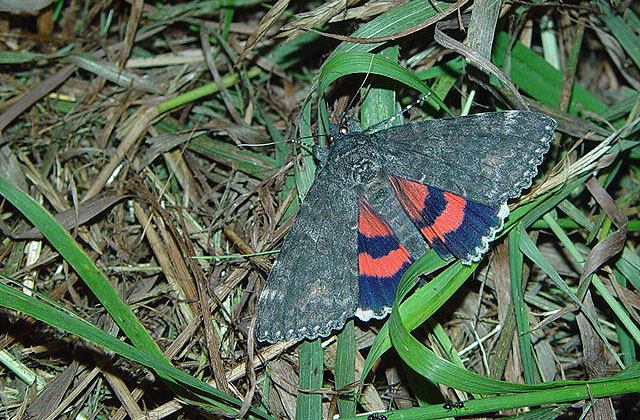
Catocala briseis dark form, courtesy of Tim Dyson.
The Catocala briseis caterpillar shows a preference for
willows and poplars.
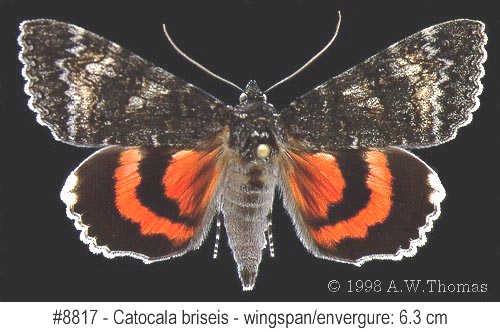
Catocala briseis
courtesy of Anthony W. Thomas.
ECLOSION:
Adults eclose from pupae at soil surface.
SCENTING AND MATING:
Catocala briseis females
emit an airbourne pheromone and males use their antennae to track the
scent plume.
EGGS, CATERPILLARS, COCOONS AND PUPAE:
Eggs are deposited on
tree bark in the fall and hatch the following spring.
The larva is
grey and tan
with fine reticulations. There are two orange spots on top of the head,
and a black arc extends from the base of the mandibles over the top of
the head. There are small orange warts on the abdominal segments
An orange and black patch divides abdominal segments five and six.
The ventral fringe is short.
This
species is not common (west coast) and feeds on willow during June and July.
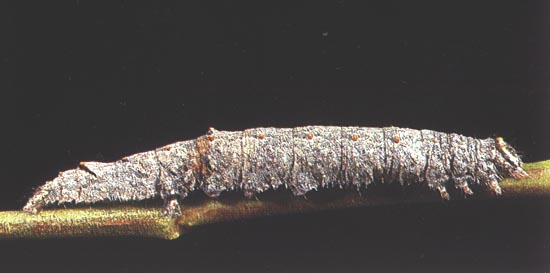
Catocala briseis
courtesy of Jeff Miller
from Caterpillars of
Pacific Northwest Forests and Woodlands.

Catocala briseis
courtesy of Martin Jagelka.
Larval Food Plants
Listed below are primary food plant(s) and alternate food plants.
It is hoped that this alphabetical listing followed by the common
name of the foodplant will prove useful. The list is not exhaustive,
although some species seem very host specific.
Experimenting with closely related foodplants is worthwhile.
Populus
Populus tremuloides......
Salix
|
Poplar
Quaking Aspen
Willow
|
Diagnostic Characters:
Wingspan: 60-70mm
Forewing dorsal surface:
1) the "teeth" of the postmedian line are not greatly elongated; except for the longest "tooth", the others are generally greatly reduced
2) there is usually a prominent, whitish, inward lining of the dark subterminal line
3) there is usually some yellowish-brown scaling in the area between the pml and the stl below the longest projection of the pml
4) the distinct subreniform spot is large, generally constricted as it joins the pml
Hindwing dorsal surface:
1) the black median band tapers as it reaches all the way to the inner margin
2) there are some dark hairs in the basal area, generally darkest along the veins
3) white fringe is heavily checked in black along veins
Forewing ventral surface:
1) the black postmedian/marginal band continues almost to the apex, fading to grey just before the apex.
Hindwing ventral surface:
1) the basal area is clear salmon except for the first two sections (sometimes the third) below the costa
2) the discal lunule is thick from the median band to the intersection with the first wing vein, becoming much thinner (just a wisp)
as it angles to the next vein
3) the small area between the lunule and the median band is also salmon
4) the first four wing sections below the costa, between the black median band and the black marginal band are usually white, sometimes
with a light suffusion of salmon in the third and/or fourth section down.
Return to Main Index
This page is brought to you by Bill Oehlke and the
WLSS. Pages are on space rented from Bizland. If you would like to become a "Patron of the Sphingidae/Catocala Sites", contact Bill.
Please send sightings/images to Bill. I will do my best to respond to requests for identification help.
Enjoy one of nature's wonderments: Live Saturniidae (Giant Silkmoth) cocoons.

|

To show appreciation for this site, click on the flashing
butterfly to the left, a link
to many worldwide insect sites. |












